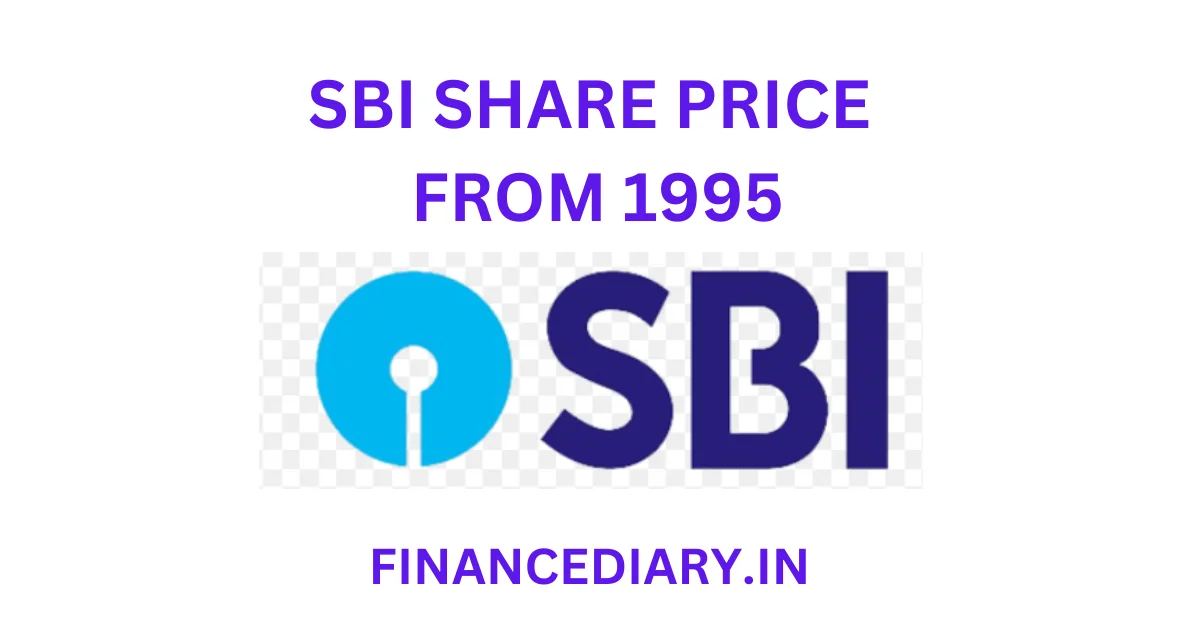In this article we provide the information related to the SBI Share price from 1995 to 2023. SBI holds the title of being the biggest bank owned by the government in India.
The State Bank of India (SBI) is a big government-owned bank in India. It’s based in Mumbai, Maharashtra, and is one of the country’s largest and oldest banks.
SBI has a strong presence both in India and in other parts of the world. SBI customer base is more than 48 crores. Its third largest population is there in SBI.
SBI SHARE PRICE FROM 1995 TO 2023
| Year | Share Price On BSE |
| 1995 | 17 |
| 1996 | 19 |
| 1997 | 30 |
| 1998 | 24 |
| 1999 | 18 |
| 2000 | 27 |
| 2001 | 23 |
| 2002 | 21 |
| 2003 | 28 |
| 2004 | 65 |
| 2005 | 62 |
| 2006 | 89 |
| 2007 | 120 |
| 2008 | 239 |
| 2009 | 137 |
| 2010 | 231 |
| 2011 | 285 |
| 2012 | 208 |
| 2013 | 255 |
| 2014 | 180 |
| 2015 | 335 |
| 2016 | 228 |
| 2017 | 268 |
| 2018 | 334 |
| 2019 | 307 |
| 2020 | 331 |
| 2021 | 310 |
| 2022 | 540 |
| 2023
As on 09.12.2023 |
619 |
ALSO READ:
HOW TO GET SBI KIT NUMBER IN ONLINE BANKING
RELIANCE POWER SHARE PRICE HISTORY
EXPLORING SBI SHARE PRICE : A LOOK BACK
SBI STOCK PRICE IN 1991
Back in 1991, the State Bank of India (SBI) wasn’t part of the Indian Stock Market. It didn’t offer its shares for trading at that time.
SBI STOCK PRICE IN 1995
Moving ahead to 1995, things changed. SBI joined the stock market, and its shares became available for people to buy and sell. The price for one share of SBI was 17 rupees.
WHY 1995 MATTERS FOR SBI SHARE PRICE
This 1995 price is essential because it marks the start of SBI’s shares being traded publicly.
Investors and experts paid attention to this moment, trying to understand how well SBI might do in the stock market.
WHAT AFFECTS SBI SHARE PRICE
To know why the price was 17 rupees in 1995, we have to consider many things. The general economy, government rules, and the health of the banking sector all played a role.
SBI’s stock price was like a signal, showing how the bank was doing in the changing financial world.
SBI’S JOURNEY AFTER 1995
After joining the stock market, SBI faced different challenges and opportunities.
The bank had to deal with ups and downs in the economy, changes in rules, and new developments in the market.
The value of SBI’s shares became a way to see not just how much money it was making but also how well it could handle changes.
HOW THE MARKET INFLUENCES SBI SHARE PRICE
SBI’s stock price wasn’t just about numbers. It went up or down based on what was happening in the overall stock market.
Good times, bad times, and what people thought about the market all affected how much one share of SBI was worth.
Investors used it as a guide to understand how SBI was doing in the big financial picture.
SBI SHARE PRICE REFLECTING CHANGES
More than just a number, SBI’s stock price was like a mirror reflecting changes in the economy and rules.
The bank’s performance showed how it adapted to new things and faced challenges in the financial world.
LOOKING BACK AT SBI’S STOCK IN 1995
Thinking about SBI’s stock price in 1995 takes us on a journey through India’s financial history.
It shows us the beginning of SBI’s public trading adventure, with each passing year revealing the bank’s strength and flexibility in dealing with the ever-changing economic landscape.
Video Credit: Vijendra Guruji
CONCLUSION
In conclusion, looking at the State Bank of India’s (SBI) stock price from 1995 to 2023 shows us a story of ups and downs.
It began at 17 rupees per share in 1995, and since then, it has been influenced by many things like changes in the economy, how the market is doing, and how well the bank itself is doing.
As the years passed, the price of SBI’s stock went up and down, reflecting the challenges and successes in the bank and the wider financial world.
This journey tells us about SBI’s ability to handle changes and stay strong in a complex banking environment.
So, from 1995 to 2023, watching SBI’s stock price has been like following a dynamic story of a bank adapting to different situations in the ever-changing financial landscape of India.
